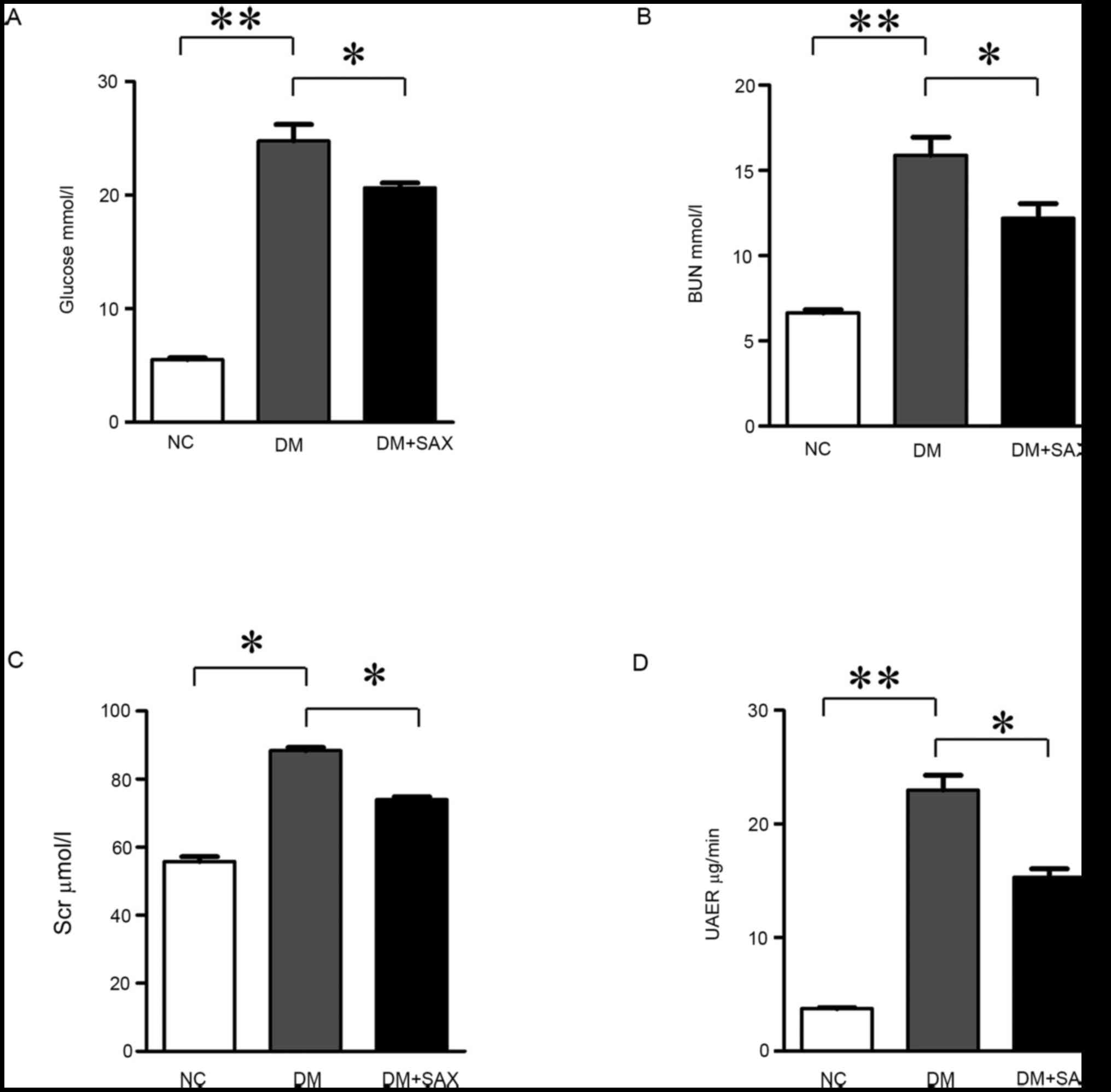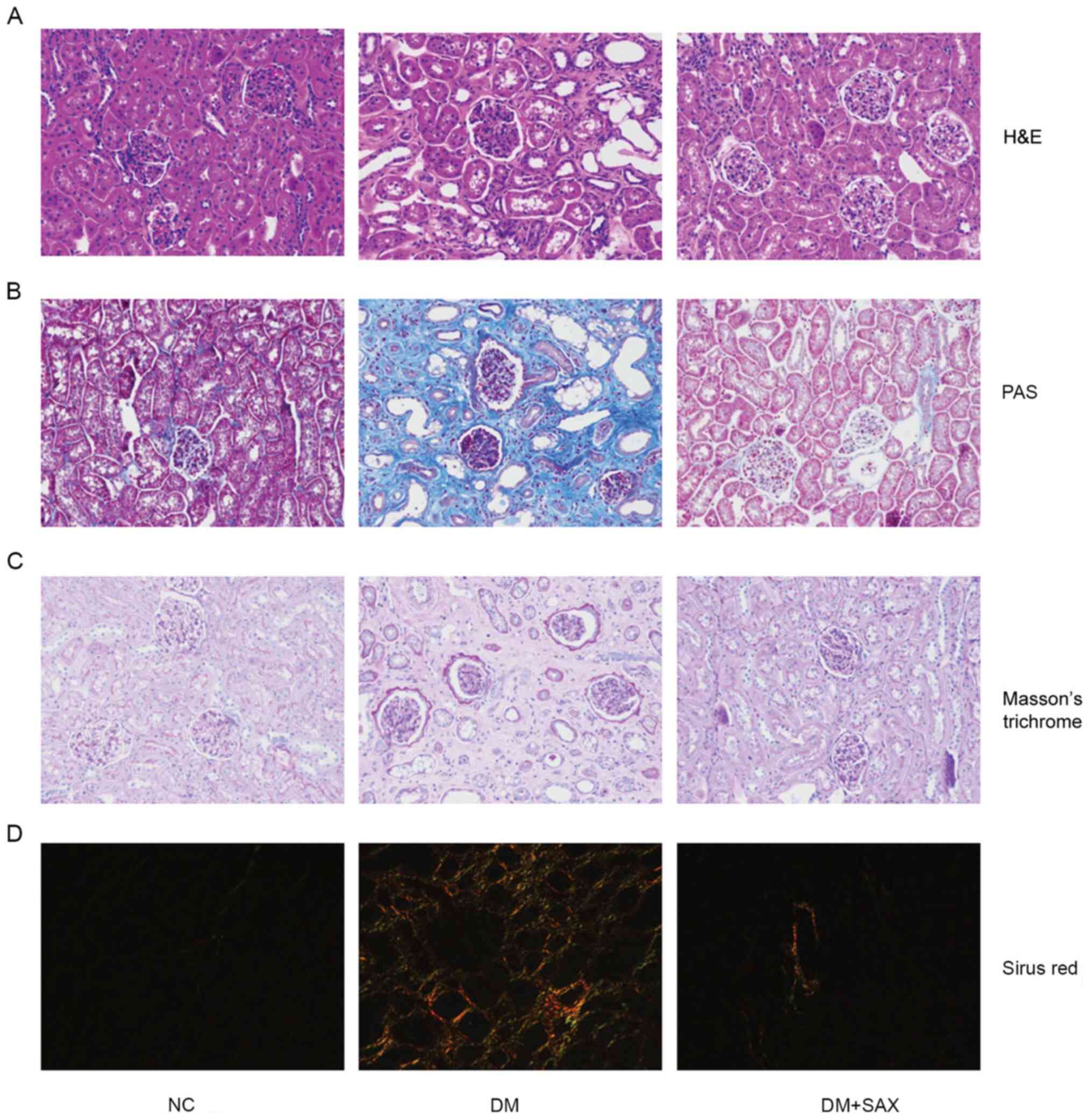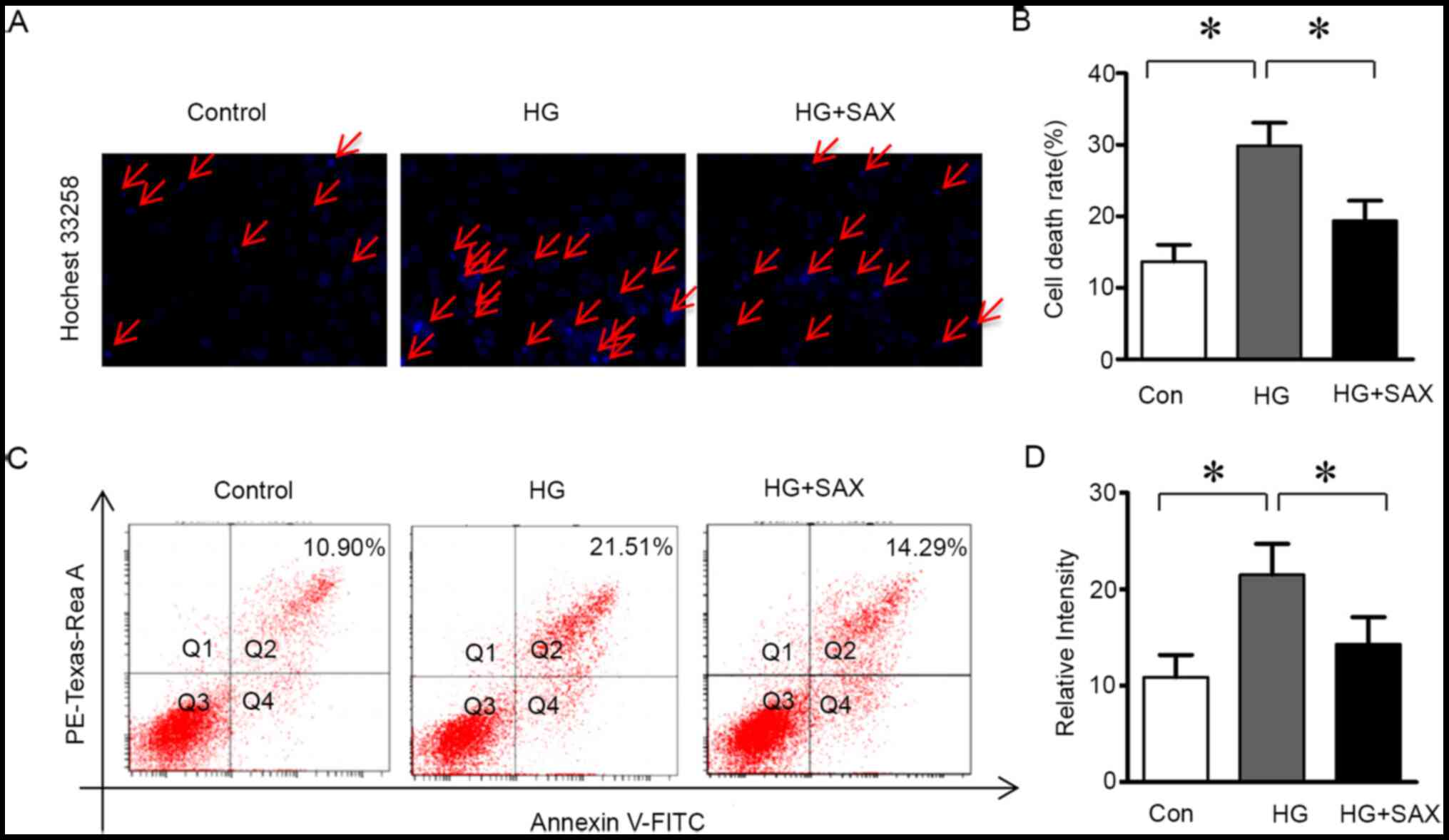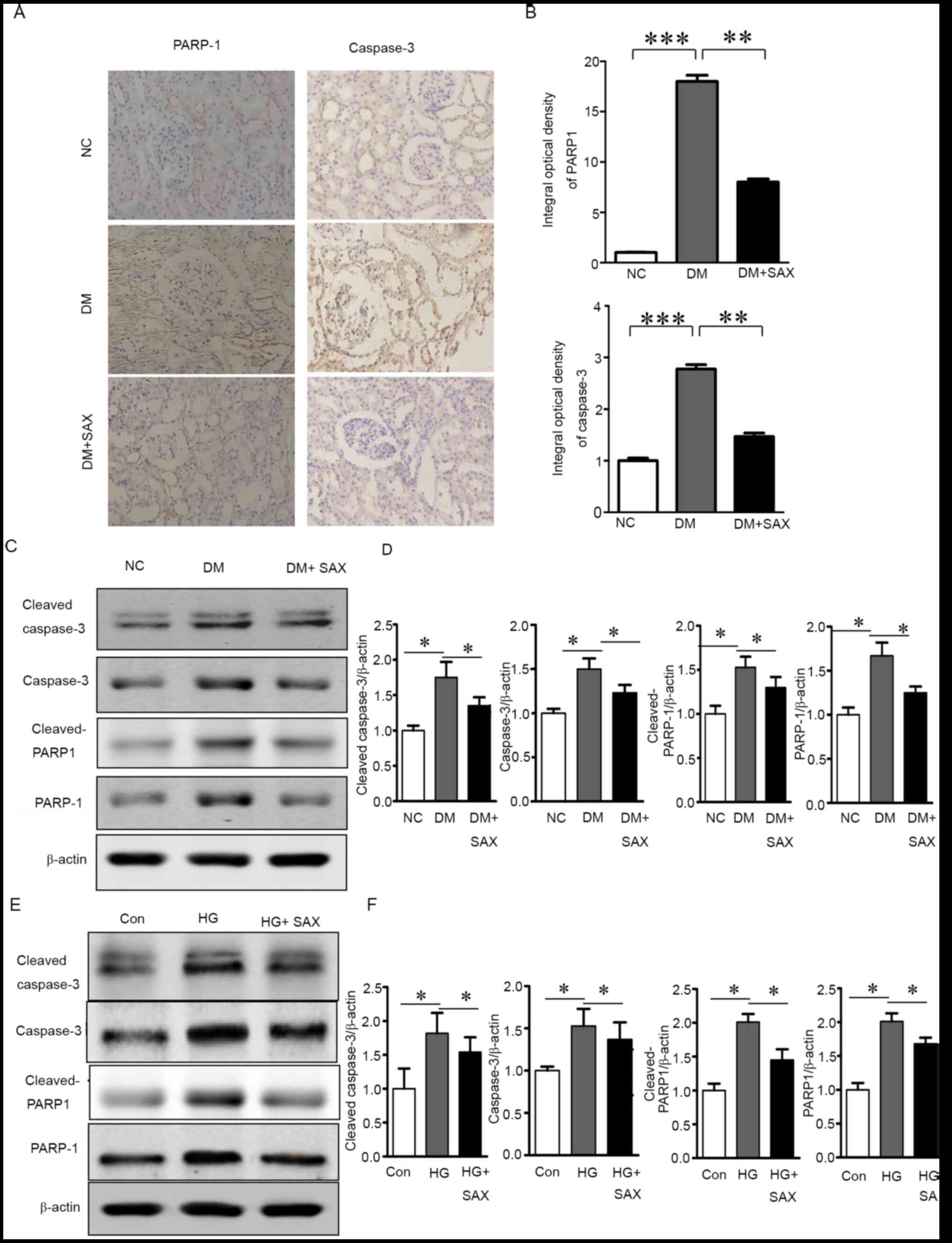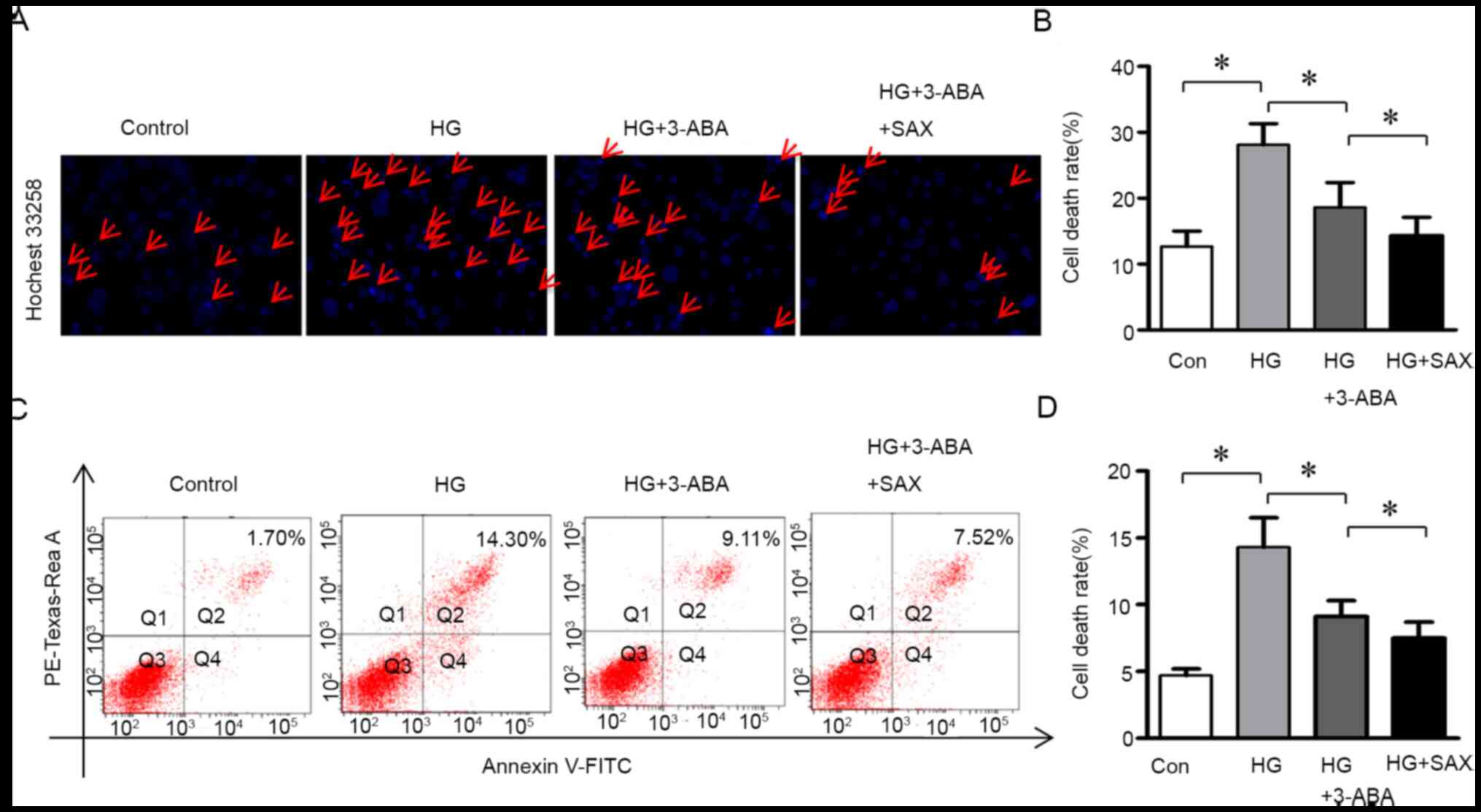|
1
|
Giacco F and Brownlee M: Oxidative stress
and diabetic complications. Circ Res. 107:1058–1070.
2010.PubMed/NCBI View Article : Google Scholar
|
|
2
|
Reidy K, Kang HM, Hostetter T and Susztak
K: Molecular mechanisms of diabetic kidney disease. J Clin Invest.
124:2333–2340. 2014.PubMed/NCBI View
Article : Google Scholar
|
|
3
|
Lindblom R, Higgins G, Coughlan M and de
Haan JB: Targeting mitochondria and reactive oxygen species-driven
pathogenesis in diabetic nephropathy. Rev Diabet Stud. 12:134–156.
2015.PubMed/NCBI View Article : Google Scholar
|
|
4
|
Dai H, Liu Q and Liu B: Research progress
on mechanism of podocyte depletion in diabetic nephropathy. J
Diabetes Res. 2017(2615286)2017.PubMed/NCBI View Article : Google Scholar
|
|
5
|
Marques C, Mega C, Goncalves A,
Rodrigues-Santos P, Teixeira-Lemos E, Teixeira F, Fontes-Ribeiro C,
Reis F and Fernandes R: Sitagliptin prevents inflammation and
apoptotic cell death in the kidney of type 2 diabetic animals.
Mediators Inflamm. 2014(538737)2014.PubMed/NCBI View Article : Google Scholar
|
|
6
|
Kanasaki K, Shi S, Kanasaki M, He J, Nagai
T, Nakamura Y, Ishigaki Y, Kitada M, Srivastava SP and Koya D:
Linagliptin-mediated DPP-4 inhibition ameliorates kidney fibrosis
in streptozotocin-induced diabetic mice by inhibiting
endothelial-to-mesenchymal transition in a therapeutic regimen.
Diabetes. 63:2120–2131. 2014.PubMed/NCBI View Article : Google Scholar
|
|
7
|
Rivero A, Mora C, Muros M, García J,
Herrera H and Navarrogonzález JF: Pathogenic perspectives for the
role of inflammation in diabetic nephropathy. Clin Sci (Lond).
116:479–492. 2009.PubMed/NCBI View Article : Google Scholar
|
|
8
|
Sanchez-Niño MD, Benito-Martin A and Ortiz
A: New paradigms in cell death in human diabetic nephropathy.
Kidney Int. 78:737–744. 2010.PubMed/NCBI View Article : Google Scholar
|
|
9
|
Wagener FA, Dekker D, Berden JH,
Scharstuhl A and van der Vlag J: The role of reactive oxygen
species in apoptosis of the diabetic kidney. Apoptosis.
14:1451–1458. 2009.PubMed/NCBI View Article : Google Scholar
|
|
10
|
Volpe CMO, Villar-Delfino PH, Dos Anjos
PMF and Nogueira-Machado JA: Cellular death, reactive oxygen
species (ROS) and diabetic complications. Cell Death Dis.
9(119)2018.PubMed/NCBI View Article : Google Scholar
|
|
11
|
Ma Y, Chen F, Yang S, Chen B and Shi J:
Protocatechuic acid ameliorates high glucose-induced extracellular
matrix accumulation in diabetic nephropathy. Biomed Pharmacother.
98:18–22. 2018.PubMed/NCBI View Article : Google Scholar
|
|
12
|
Gray SP and Jandeleit-Dahm K: The
pathobiology of diabetic vascular complications-cardiovascular and
kidney disease. J Mol Med (Berl). 92:441–452. 2014.PubMed/NCBI View Article : Google Scholar
|
|
13
|
Szabó C, Biser A, Benko R, Böttinger E and
Suszták K: Poly(ADP-ribose) polymerase inhibitors ameliorate
nephropathy of type 2 diabetic Leprdb/db mice. Diabetes.
55:3004–3012. 2006.PubMed/NCBI View Article : Google Scholar
|
|
14
|
Shevalye H, Maksimchyk Y, Watcho P and
Obrosova IG: Poly(ADP-ribose) polymerase-1 (PARP-1) gene deficiency
alleviates diabetic kidney disease. Biochim Biophys Acta.
1802:1020–1027. 2010.PubMed/NCBI View Article : Google Scholar
|
|
15
|
Chao LK, Chang WT, Shih YW and Huang JS:
Cinnamaldehyde impairs high glucose-induced hypertrophy in renal
interstitial fibroblasts. Toxicol Appl Pharmacol. 244:174–180.
2010.PubMed/NCBI View Article : Google Scholar
|
|
16
|
Lau GJ, Godin N, Maachi H, Lo CS, Wu SJ,
Zhu JX, Brezniceanu ML, Chénier I, Fragasso-Marquis J, Lattouf JB,
et al: Bcl-2-modifying factor induces renal proximal tubular cell
apoptosis in diabetic mice. Diabetes. 61:474–484. 2012.PubMed/NCBI View Article : Google Scholar
|
|
17
|
Covington MD and Schnellmann RG: Chronic
high glucose downregulates mitochondrial calpain 10 and contributes
to renal cell death and diabetes-induced renal injury. Kidney Int.
81:391–400. 2012.PubMed/NCBI View Article : Google Scholar
|
|
18
|
Sharkovska Y, Reichetzeder C, Alter M,
Tsuprykov O, Bachmann S, Secher T, Klein T and Hocher B: Blood
pressure and glucose independent renoprotective effects of
dipeptidyl peptidase-4 inhibition in a mouse model of type-2
diabetic nephropathy. J Hypertens. 32:2211–2223. 2014.PubMed/NCBI View Article : Google Scholar
|
|
19
|
Borzi AM, Condorelli G, Biondi A, Basile
F, Vicari ESD, Buscemi C, Luca S and Vacante M: Effects of
vildagliptin, a DPP-4 inhibitor, in elderly diabetic patients with
mild cognitive impairment. Arch Gerontol Geriatr.
84(103896)2019.PubMed/NCBI View Article : Google Scholar
|
|
20
|
Shi S, Koya D and Kanasaki K: Dipeptidyl
peptidase-4 and kidney fibrosis in diabetes. Fibrogenesis Tissue
Repair. 9(1)2016.PubMed/NCBI View Article : Google Scholar
|
|
21
|
Itou M, Kawaguchi T, Taniguchi E and Sata
M: Dipeptidyl peptidase-4: A key player in chronic liver disease.
World J Gastroenterol. 19:2298–2306. 2013.PubMed/NCBI View Article : Google Scholar
|
|
22
|
Shirakawa J, Fujii H, Ohnuma K, Sato K,
Ito Y, Kaji M, Sakamoto E, Koganei M, Sasaki H, Nagashima Y, et al:
Diet-induced adipose tissue inflammation and liver steatosis are
prevented by DPP-4 inhibition in diabetic mice. Diabetes.
60:1246–1257. 2011.PubMed/NCBI View Article : Google Scholar
|
|
23
|
Nistala R, Habibi J, Aroor A, Sowers JR,
Hayden MR, Meuth A, Knight W, Hancock T, Klein T, Demarco VG and
Whaley-Connell A: DPP4 inhibition attenuates filtration barrier
injury and oxidant stress in the zucker obese rat. Obesity (Silver
Spring). 22:2172–2179. 2014.PubMed/NCBI View Article : Google Scholar
|
|
24
|
Groop PH, Cooper ME, Perkovic V, Emser A,
Woerle HJ and Eynatten M: Linagliptin lowers albuminuria on top of
recommended standard treatment in patients with type 2 diabetes and
renal dysfunction. Diabetes Care. 36:3460–3468. 2013.PubMed/NCBI View Article : Google Scholar
|
|
25
|
Ommen ES, Xu L, O'Neill EA, Goldstein BJ,
Kaufman KD and Engel SS: Comparison of treatment with sitagliptin
or sulfonylurea in patients with type 2 diabetes mellitus and mild
renal impairment: A post hoc analysis of clinical trials. Diabetes
Ther. 6:29–40. 2015.PubMed/NCBI View Article : Google Scholar
|
|
26
|
Lim S, Han KA, Yu J, Chamnan P, Kim ES,
Yoon KH, Kwon S, Moon MK, Lee KW, Kim DJ, et al: Efficacy and
safety of initial combination therapy with gemigliptin and
metformin compared with monotherapy with either drug in patients
with type 2 diabetes: A double-blind randomized controlled trial
(INICOM study). Diabetes Obes Metab. 19:87–97. 2017.PubMed/NCBI View Article : Google Scholar
|
|
27
|
Hardy G: Saxagliptin demonstrates no
increased risk for cardiovascular death, heart attack or stroke in
the SAVOR cardiovascular outcomes trial. Cardiovasc J Afr.
24(290)2013.PubMed/NCBI
|
|
28
|
Ott C, Raff U, Schmidt S, Kistner I,
Friedrich S, Bramlage P, Harazny JM and Schmieder RE: Effects of
saxagliptin on early microvascular changes in patients with type 2
diabetes. Cardiovasc Diabetol. 13(19)2014.PubMed/NCBI View Article : Google Scholar
|
|
29
|
Roy D, Chadwick KD, Tatarkiewicz K,
LaCerte C, Bergholm AM, Brodie T, Mangipudy RS, Parkes D, Graziano
MJ and Reilly TP: The glucagon-like peptide-1-based therapeutics
exenatide and saxagliptin did not cause detrimental effects on the
pancreas in mice, rats, dogs and monkeys. Diabetes Obes Metab.
16:910–921. 2014.PubMed/NCBI View Article : Google Scholar
|
|
30
|
Lee TI, Kao YH, Tsai WC, Chung CC, Chen YC
and Chen YJ: HDAC inhibition modulates cardiac PPARs and fatty acid
metabolism in diabetic cardiomyopathy. PPAR Res.
2016(5938740)2016.PubMed/NCBI View Article : Google Scholar
|
|
31
|
Bae EJ: DPP-4 inhibitors in diabetic
complications: Role of DPP-4 beyond glucose control. Arch Pharm
Res. 39:1114–1128. 2016.PubMed/NCBI View Article : Google Scholar
|
|
32
|
Xiao T, Guan X, Nie L, Wang S, Sun L, He
T, Huang Y, Zhang J, Yang K, Wang J and Zhao J: Rapamycin promotes
podocyte autophagy and ameliorates renal injury in diabetic mice.
Mol Cell Biochem. 394:145–154. 2014.PubMed/NCBI View Article : Google Scholar
|
|
33
|
Lv M, Chen Z, Hu G and Li Q: Therapeutic
strategies of diabetic nephropathy: Recent progress and future
perspectives. Drug Discov Today. 20:332–346. 2015.PubMed/NCBI View Article : Google Scholar
|
|
34
|
Jefferson JA, Shankland SJ and Pichler RH:
Proteinuria in diabetic kidney disease: A mechanistic viewpoint.
Kidney Int. 74:22–36. 2008.PubMed/NCBI View Article : Google Scholar
|
|
35
|
Flyvbjerg A: The role of the complement
system in diabetic nephropathy. Nat Rev Nephrol. 13:311–318.
2017.PubMed/NCBI View Article : Google Scholar
|
|
36
|
Xiao L, Wang M, Yang S, Liu F and Sun L: A
glimpse of the pathogenetic mechanisms of Wnt/β-catenin signaling
in diabetic nephropathy. Biomed Res Int.
2013(987064)2013.PubMed/NCBI View Article : Google Scholar
|
|
37
|
Schernthaner G, Durán-Garcia S, Hanefeld
M, Langslet G, Niskanen L, Östgren CJ, Malvolti E and Hardy E:
Efficacy and tolerability of saxagliptin compared with glimepiride
in elderly patients with type 2 diabetes: A randomized, controlled
study (GENERATION). Diabetes Obes Metab. 17:630–638.
2015.PubMed/NCBI View Article : Google Scholar
|
|
38
|
Scheen AJ: DPP-4 inhibitors in the
management of type 2 diabetes: A critical review of head-to-head
trials. Diabetes Metab. 38:89–101. 2012.PubMed/NCBI View Article : Google Scholar
|
|
39
|
Garg K, Tripathi CD and Kumar S: Clinical
review of sitagliptin: A DPP-4 inhibitor. J Assoc Physicians India.
61:645–649. 2013.PubMed/NCBI
|
|
40
|
Cai Y, Lydic TA, Turkette T, Reid GE and
Olson LK: Impact of alogliptin and pioglitazone on lipid metabolism
in islets of prediabetic and diabetic zucker diabetic fatty rats.
Biochem Pharmacol. 95:46–57. 2015.PubMed/NCBI View Article : Google Scholar
|
|
41
|
Verzola D, Bertolotto MB, Villaggio B,
Ottonello L, Dallegri F, Frumento G, Berruti V, Gandolfo MT,
Garibotto G and Deferran G: Taurine prevents apoptosis induced by
high ambient glucose in human tubule renal cells. J Investig Med.
50:443–451. 2002.PubMed/NCBI View Article : Google Scholar
|
















